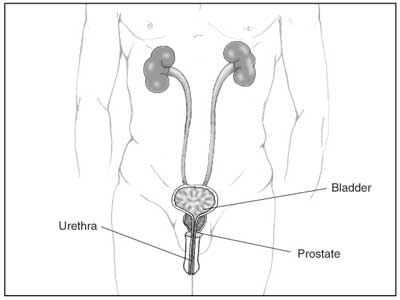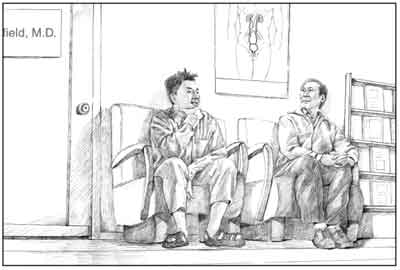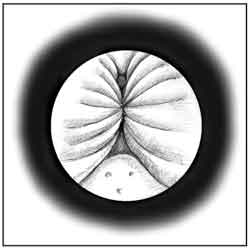Featured Health Support Products
Healthy Prostate & Ovary with Crinum Latifolium!
Herbal Supplement for Prostate & Ovarian Health*
For Men - May Offer Support For:
- Overall Prostate Health*
- Benign Prostatic Hypertrophy-Free Health*
- Non-Painful or Non-Frequent Urinary Health*
- Male Urination Normalcy*
For Women - May Offer Support For:
- Overall Ovarian Health*
- Ovarian Cyst-Free Health*
- Female Hormonal Healthy Balance*
100% Money Back Guarantee!
What are Prostate Problems?
Prostate Diseases
The prostate is a gland. It helps make semen, the fluid that contains sperm. The prostate surrounds the tube that carries urine away from the bladder and out of the body. A young man's prostate is about the size of a walnut. It slowly grows larger with age. If it gets too large, it can cause problems. This is very common after age 50. The older men get, the more likely they are to have prostate trouble.
Some common problems are
- Prostatitis - an infection, usually caused by bacteria
- Benign prostatic hyperplasia, or BPH - an enlarged prostate, which may cause dribbling after urination or a need to go often, especially at night
- Prostate cancer - a common cancer that responds best to treatment when detected early
National Institute of Diabetes and Digestive and Kidney Diseases
Source: http://www.nlm.nih.gov/medlineplus/prostatediseases.html
[Top]
Read About Prostate Health Support...*
[Top]
What I need to know about Prostate Problems
On this page:
- What is the prostate?
- What are prostate problems?
- What is prostatitis?
- What is prostate enlargement, or BPH?
- Is BPH a sign of cancer?
- Is BPH a serious disease?
- What tests will my doctor order?
- How is BPH treated?
- Is TURP the same as removing the prostate?
- What are the side effects of prostate treatments?
- Hope through Research
- Pronunciation Guide
- For More Information
- Acknowledgments
What is the prostate?
The prostate is part of a man's sex organs. It's about the size of a walnut and surrounds the tube called the urethra, located just below the bladder.
The urethra has two jobs: to carry urine from the bladder when you urinate and to carry semen during a sexual climax, or ejaculation. Semen is a combination of sperm plus fluid that the prostate adds.

The male urinary tract. The prostate surrounds the urethra, where urine leaves the bladder.
[Top]
What are prostate problems?
For men under 50, the most common prostate problem is prostatitis.
For men over 50, the most common prostate problem is prostate enlargement. This condition is also called benign prostatic hyperplasia (BPH). Older men are at risk for prostate cancer as well, but this disease is much less common than BPH. More information about prostate cancer is available from the National Cancer Institute.

For younger men, the most common prostate problem is prostatitis. For older men, it's an enlarged prostate.
[Top]
What is prostatitis?
Prostatitis means the prostate might be inflamed or irritated. If you have prostatitis, you may have a burning feeling when you urinate, or you may have to urinate more often. Or you may have a fever or just feel tired.
Inflammation in any part of the body is usually a sign that the body is fighting germs or repairing an injury. Some kinds of prostatitis are caused by bacteria, tiny organisms that can cause infection or disease. If you have bacterial prostatitis, your doctor can look through a microscope and find bacteria in a sample of your urine. Your doctor can then give you an antibiotic, a medicine that kills bacteria.

If you have bacterial prostatitis, your doctor can look through a microscope and find bacteria in a sample of your urine.
Most of the time, doctors don't find any bacteria in men with prostatitis. If you have urinary problems, the doctor will look for other possible causes, such as a kidney stone or cancer.
If no other causes are found, the doctor may decide you have a condition called nonbacterial prostatitis.
You may have to work with your doctor to find a treatment that's right for you. Changing your diet or taking warm baths may help. Your doctor may give you a medicine called an alpha-blocker to relax the muscle tissue in the prostate. No single solution works for everyone with this condition.

Work with your doctor to find a treatment that's right for you.
[Top]
What is prostate enlargement, or BPH?
If you're a man over 50 and have started having problems urinating, the reason could be an enlarged prostate, or BPH. As men get older, their prostate keeps growing. As it grows, it squeezes the urethra. Since urine travels from the bladder through the urethra, the pressure from the enlarged prostate may affect bladder control.
If you have BPH, you may have one or more of these problems:
-
A frequent and urgent need to urinate. You may get up several times a night to go to the bathroom.

Frequent urination at night may be a sign of an enlarged prostate. - Trouble starting a urine stream. Even though you feel you have to rush to get to the bathroom, you find it hard to start urinating.
- A weak stream of urine
- A small amount of urine each time you go
- The feeling that you still have to go, even when you have just finished urinating
- Leaking or dribbling urine
- Small amounts of blood in your urine
[Top]
Is BPH a sign of cancer?
No. It's true that some men with prostate cancer also have BPH, but that doesn't mean that the two conditions are always linked. Most men with BPH don't develop prostate cancer. However, because the early symptoms are the same for both conditions, you should see a doctor to evaluate these symptoms.
[Top]
Is BPH a serious disease?
By itself, BPH is not a serious condition, unless the symptoms are so bothersome that you can't enjoy life. But BPH can lead to serious problems. One problem is urinary tract infections.
If you can't urinate at all, you should get medical help right away. Sometimes this happens suddenly to men after they take an over-the-counter cold or allergy medicine.
In rare cases, BPH and its constant urination problems can lead to kidney damage.
[Top]
What tests will my doctor order?
Several tests help the doctor identify the problem and decide on the best treatment.
- Digital rectal exam. This exam is usually the first test done. The doctor inserts a gloved finger into the rectum and feels the prostate, which sits directly in front of the rectum. This exam gives the doctor a general idea of the size and condition of the prostate.
- Blood test. The doctor may want to test a sample of your blood to look for prostate-specific antigen (PSA). If your PSA is high, it may be a sign that you have prostate cancer. But this test isn't perfect. Many men with high PSA scores don't have prostate cancer.
- Imaging. The doctor may want to get a picture of your prostate using either x rays or a sonogram. An intravenous pyelogram (IVP) is an x ray of the urinary tract. For an IVP, dye will be injected into a vein. Later, when the dye passes out of your blood into your urine, it will show up on the x ray. A rectal sonogram uses a probe, inserted into the rectum, to bounce sound waves off the prostate.
- Urine flow study. You may be asked to urinate into a special device that measures how quickly the urine is flowing. A reduced flow may mean you have BPH.
- Cystoscopy. Another way to see a problem from the inside is with a cystoscope, which is a thin tube with lenses like a microscope. The tube is inserted into the bladder through the urethra while the doctor looks through the cystoscope.

Cystoscopic view of enlarged prostate from inside the urethra.
[Top]
How is BPH treated?
Several treatments are available. Work with your doctor to find the one that's best for you.
- Watchful waiting. If your symptoms don't bother you too much, you may choose to live with them rather than take pills every day or have surgery. But you should have regular checkups to make sure your condition isn't getting worse. With watchful waiting, you can be ready to choose a treatment as soon as you need it.
- Medicines. In recent years, scientists have developed several medicines to shrink or relax the prostate to keep it from blocking the bladder opening.
- Nonsurgical procedures. A number of devices have been developed that allow doctors to remove parts of the prostate during nonsurgical procedures. These procedures can usually be done in a clinic or hospital without an overnight stay. The procedures are transurethral, which means the doctor reaches the area by going through the urethra. The doctor uses thin tubes inserted through the urethra to deliver controlled heat to small areas of the prostate.
A gel may be applied to the urethra to prevent pain or discomfort. You won't need drugs that make you go to sleep. Several transurethral procedures are treatments for BPH:
- PVP (photoselective vaporization of the prostate): destroys excess prostate tissue interfering with the exit of urine from the body by using a controlled laser beam inside the prostate.
- TUIP (transurethral incision of the prostate): widens the urethra by making a few small cuts in the bladder neck, where the urethra joins the bladder, and in the prostate gland itself.
- TUMT (transurethral microwave thermotherapy): destroys prostate tissue by using a probe in the urethra to deliver microwaves.
- TUNA (transurethral needle ablation): destroys excess prostate tissue with electromagnetically generated heat by using a needle-like device in the urethra.

In TUMT, microwaves heat part of the prostate. - Surgical treatment. Surgery to remove a piece of the prostate can be done through the urethra or in open surgery, which requires cutting through the skin above the base of the penis. Your doctor may recommend open surgery if your prostate is especially large. The most common surgery is called transurethral resection of the prostate (TURP). In TURP, the surgeon inserts a thin tube up the urethra and cuts away pieces of the prostate with a wire loop while looking through a cystoscope. TURP and open surgery both require general anesthesia and a stay in the hospital.
[Top]
Is TURP the same as removing the prostate?
No. TURP and other procedures for BPH remove only enough tissue to relieve urine blockage. In a few cases, the prostate may continue to grow, and urinary problems return. You should continue to have your prostate checked once a year even after surgery to make sure that BPH or prostate cancer has not developed.
A prostate removal, or radical prostatectomy, is usually done only to stop prostate cancer from spreading.

In TURP, a wire loop is used to cut away pieces of the prostate.
[Top]
What are the side effects of prostate treatments?
Surgery for BPH may have a temporary effect on sexual function. Most men recover complete sexual function within a year after surgery. The exact length of time depends on how long you had symptoms before surgery was done and on the type of surgery. After TURP, some men find that semen does not go out of the penis during orgasm. Instead, it goes backwards into the bladder. In some cases, this condition can be treated with a drug that helps keep the bladder closed. A doctor who specializes in fertility problems may be able to help if backwards ejaculation causes a problem for a couple trying to get pregnant.
If you have any problems after treatment for a prostate condition, talk with your doctor or nurse. Erection problems and loss of bladder control can be treated, and chances are good that you can be helped.
If your prostate is removed completely to stop cancer, you're more likely to have long-lasting sexual and bladder control problems, such as leaking or dribbling. Your doctor may be able to use a technique that leaves the nerves around the prostate in place. This procedure makes it easier for you to regain bladder control and sexual function. Not all men can have this technique, but most men can be helped with other medical treatments.
[Top]
Hope through Research
The National Institute of Diabetes and Digestive and Kidney Diseases (NIDDK) has many research programs aimed at finding treatments for urinary disorders, including prostatitis and BPH. The Medical Therapy of Prostate Symptoms (MTOPS) program is studying the results of medical therapy used to treat thousands of men with BPH in several research centers throughout the country. MTOPS will provide valuable information about the effectiveness and side effects of drugs being used for BPH.
Research is also under way to evaluate new approaches to surgical treatment of BPH. The Minimally Invasive Surgical Therapies (MIST) treatment group is looking at TUMT, TUNA, and other transurethral treatments for BPH that generally do not require a hospital stay. Studies are planned to assess the effectiveness of saw palmetto and other herbal remedies for this disorder.

Problems with bladder control and sexual function can be treated. Chances are good that you can be helped.
[Top]
Pronunciation Guide
antibiotic (AN-tee-by-OT-ik)
bacteria (bak-TIHR-ee-uh)
benign prostatic hyperplasia (BPH) (bee-NYN) (pross-TAT-ik) (hy-pur-PLAY-zhee-uh)
cystoscope (SISS-toh-skohp)
ejaculation (ee-JAK-yoo-LAY-shuhn)
intravenous pyelogram (IVP) (IN-truh-VEE-nuhss) (PY-el-oh-GRAM)
prostate (PROSS-tayt)
prostatitis (PROSS-tuh-TY-tiss)
radical prostatectomy (RAD-ih-kuhl) (PROSS-tuh-TEK-tuh-mee)
transurethral (TRANZ-yoo-REE-thruhl)
urethra (yoo-REE-thruh)
[Top]
For More Information
The National Kidney and Urologic Deseases Information Clearinghouse (NKUDIC) has a fact sheet, Prostate Enlargement: Benign Prostatic Hyperplasia, that gives more information about BPH. Another fact sheet, Prostatitis: Disorders of the Prostate, discusses four types of prostate inflammation. Call 1-800-891-5390 to speak to an NKUDIC information specialist and request these publications, or use the online catalog.
More information is available from the following organizations:
American Urological Association Foundation
1000 Corporate Boulevard
Linthicum, MD 21090
Phone: 1-866-RING?AUA (746-4282) or 410-689-3700
Fax: 410-689-3800
Email: patienteducation@auafoundation.org
Internet: www.auafoundation.org
www.UrologyHealth.org
The Prostatitis Foundation
1063 30th Street, Box 8
Smithshire, IL 61478
Phone: 1-888-891-4200
Fax: 309-325-7184
Internet: www.prostatitis.org
For information about prostate cancer, contact the
National Cancer Institute (NCI)
Cancer Information Service
Phone: 1-800-4CANCER (422-6237)
TTY: 1-800-332-8615
Email: cancermail@icicc.nci.nih.gov
Internet: www.cancer.gov
[Top]
Acknowledgments
The National Kidney and Urologic Diseases Information Clearinghouse (NKUDIC) would like to thank the following individuals for assisting with the scientific and editorial review of this publication.
Toby Chai, M.D.
University of MarylandNancy Mueller, R.N.
Office of Edward J. Mueller, M.D.
San Antonio, TX
Thank you also to Bread for the City free clinic in Washington, DC, for facilitating field-testing of this publication.
This publication may contain information about medications used to treat a health condition. When this publication was prepared, the NIDDK included the most current information available. Occasionally, new information about medication is released. For updates or for questions about any medications, please contact the U.S. Food and Drug Administration at 1-888-INFO-FDA (463-6332), a toll-free call, or visit their website at www.fda.gov. Consult your doctor for more information.
[Top]
National Kidney and Urologic Diseases Information Clearinghouse
3 Information Way
Bethesda, MD 20892-3580
Phone: 1-800-891-5390
TTY: 1-866-569-1162
Fax: 703-738-4929
Email: nkudic@info.niddk.nih.gov
Internet: www.kidney.niddk.nih.gov
The National Kidney and Urologic Diseases Information Clearinghouse (NKUDIC) is a service of the National Institute of Diabetes and Digestive and Kidney Diseases (NIDDK). The NIDDK is part of the National Institutes of Health of the U.S. Department of Health and Human Services. Established in 1987, the Clearinghouse provides information about diseases of the kidneys and urologic system to people with kidney and urologic disorders and to their families, health care professionals, and the public. The NKUDIC answers inquiries, develops and distributes publications, and works closely with professional and patient organizations and Government agencies to coordinate resources about kidney and urologic diseases.
Source: http://kidney.niddk.nih.gov/kudiseases/pubs/prostate_ez/
Read About Prostate Health Support...*
[Top]

 Get Well Natural, LLC
Get Well Natural, LLC  Kidney Function & Regeneration Health
Kidney Function & Regeneration Health  Platelet & Blood Cell Health
Platelet & Blood Cell Health  Prostate, Flow & Function Health
Prostate, Flow & Function Health  General Mind & Body Health
General Mind & Body Health  Heart, Cholesterol & Cardio Health
Heart, Cholesterol & Cardio Health  Allergy-Free Body
Allergy-Free Body  Anxiety & Stress
Anxiety & Stress  Blood Platelet Counts & Function
Blood Platelet Counts & Function  Blood Pressure Health
Blood Pressure Health  Kidney Function Health
Kidney Function Health  Immune System Health & Balance
Immune System Health & Balance  Prostate & Urinary Health Function
Prostate & Urinary Health Function  Blood Sugar Balance
Blood Sugar Balance  Cardiovascular Heart Health
Cardiovascular Heart Health  Detoxification & Healthy Cells
Detoxification & Healthy Cells  Women's Health
Women's Health  Liver Regeneration
Liver Regeneration  Pain-Free Body
Pain-Free Body  Water & Air Filtration
Water & Air Filtration 


